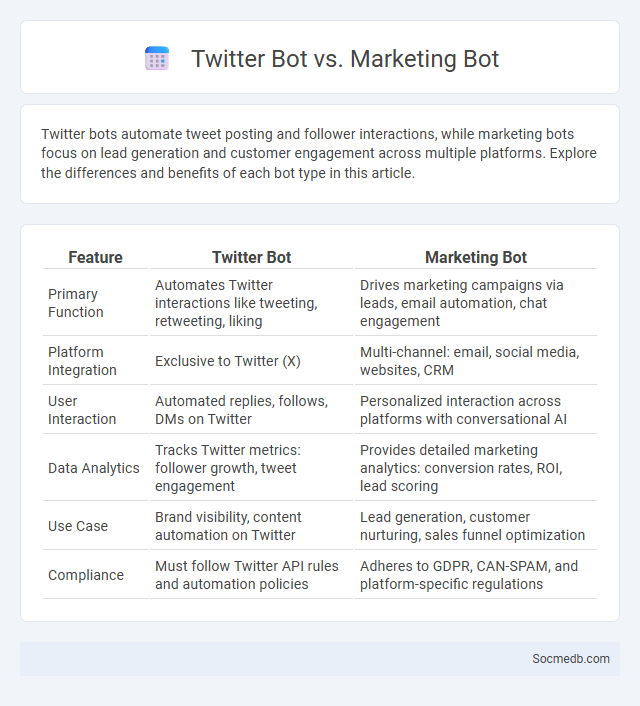
Photo illustration: Twitter Bot vs Marketing Bot
Twitter bots automate tweet posting and follower interactions, while marketing bots focus on lead generation and customer engagement across multiple platforms. Explore the differences and benefits of each bot type in this article.
Table of Comparison
| Feature | Twitter Bot | Marketing Bot |
|---|---|---|
| Primary Function | Automates Twitter interactions like tweeting, retweeting, liking | Drives marketing campaigns via leads, email automation, chat engagement |
| Platform Integration | Exclusive to Twitter (X) | Multi-channel: email, social media, websites, CRM |
| User Interaction | Automated replies, follows, DMs on Twitter | Personalized interaction across platforms with conversational AI |
| Data Analytics | Tracks Twitter metrics: follower growth, tweet engagement | Provides detailed marketing analytics: conversion rates, ROI, lead scoring |
| Use Case | Brand visibility, content automation on Twitter | Lead generation, customer nurturing, sales funnel optimization |
| Compliance | Must follow Twitter API rules and automation policies | Adheres to GDPR, CAN-SPAM, and platform-specific regulations |
Introduction to Bots: Twitter Bots, Marketing Bots, and General Bots
Social media bots automate interactions and tasks, significantly enhancing efficiency and engagement across platforms. Twitter bots specialize in posting tweets, retweeting, and following users to amplify reach, while marketing bots focus on personalized customer engagement, lead generation, and analytics. Understanding how these general bots function enables you to leverage automation for optimized content distribution and improved user experience.
What is a Twitter Bot?
A Twitter bot is an automated software application designed to perform tasks such as posting tweets, retweeting content, or following accounts based on predefined rules or algorithms. These bots can help you amplify your social media presence by engaging with followers, scheduling posts, or tracking hashtags efficiently. Understanding how Twitter bots operate enables you to leverage automation for marketing, customer service, or real-time updates on your platform.
What is a Marketing Bot?
A marketing bot is an automated software tool designed to perform marketing tasks such as social media engagement, customer interaction, and lead generation. It uses artificial intelligence and machine learning algorithms to analyze audience behavior, personalize content, and optimize campaigns for better results. Your business can leverage a marketing bot to increase efficiency, improve customer targeting, and boost overall marketing ROI.
Understanding General Bots
General bots on social media platforms automate interactions such as liking, commenting, and following to amplify content reach or simulate engagement. Understanding their behavior helps you distinguish between authentic user activity and automated responses, improving your ability to manage online reputation. Identifying patterns like repetitive messages or unnatural posting frequency is key to recognizing these bots effectively.
Core Functions: Twitter Bots vs Marketing Bots
Twitter bots primarily automate content sharing, follower engagement, and trend monitoring, boosting real-time interaction on the platform by mimicking human behavior. Marketing bots, on the other hand, specialize in lead generation, customer support, and personalized ad targeting across multiple social media channels to enhance brand visibility and conversion rates. Both types utilize AI-driven algorithms but serve distinct roles: Twitter bots enhance social interaction, while marketing bots optimize sales funnels and customer relationship management.
Key Differences Among Twitter Bots, Marketing Bots, and General Bots
Twitter bots are automated accounts that primarily engage in tweeting, retweeting, and following activities to amplify content or influence conversations on the platform. Marketing bots focus on promoting products or services by targeting specific audiences, managing ad campaigns, and analyzing user behavior for better engagement. Your understanding of these distinctions helps optimize automation strategies by selecting the appropriate bot type for brand visibility, customer interaction, or operational efficiency.
Use Cases: Where Are These Bots Applied?
Social media bots are extensively applied in customer service to automate responses and enhance user engagement across platforms like Facebook Messenger and Twitter. They play a crucial role in marketing campaigns by managing brand reputation, distributing content, and analyzing audience sentiment on channels such as Instagram and LinkedIn. These bots also monitor social trends, detect fake accounts, and conduct social listening to provide valuable insights for businesses and policymakers.
Benefits and Limitations of Each Bot Type
Social media bots offer diverse benefits such as automating repetitive tasks, increasing engagement, and providing real-time customer support to enhance your online presence. Rule-based bots excel in handling straightforward queries with predictable responses but lack adaptability in complex interactions. AI-powered bots deliver personalized experiences and understand nuanced conversations but may require significant resources for development and maintenance.
Security and Ethical Considerations
Social media platforms face ongoing challenges in safeguarding user privacy and preventing data breaches, necessitating robust encryption and multi-factor authentication protocols. Ethical considerations include combating misinformation, protecting vulnerable groups from cyberbullying, and ensuring transparent content moderation to uphold digital rights. Implementing stringent security measures alongside ethical guidelines is critical to maintaining trust and accountability in the social media ecosystem.
Choosing the Right Bot for Your Needs
Selecting the right social media bot involves evaluating your specific goals such as improving engagement, automating posts, or growing follower counts efficiently. Tools like ManyChat excel in chatbot automation for customer interaction, while platforms like Hootsuite offer advanced scheduling and analytics features suitable for brand management. Prioritize bots with robust security measures and customizable settings to ensure optimal performance aligned with your marketing strategy.
 socmedb.com
socmedb.com